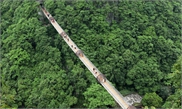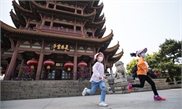Holiday economy rebounds
Travelers made 115m trips, spent $6.74b during May Day holiday
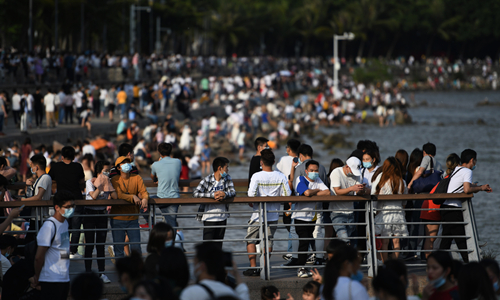
Many tourists go to the Shenzhen Bay Park in South China's Guangdong Province to enjoy the scenery on May 1. (Photo: VCG)
China on Tuesday marked a milestone in its efforts to recover from the coronavirus pandemic, as over 100 million tourists flocked to popular attraction sites across the country during the just-concluded May Day holiday and spent billions of dollars, all while averting a much-feared resurgence of COVID-19 cases.
While the final tally on trips and consumption during the five-day holiday remains low compared to that of last year due largely to remaining anti-epidemic efforts and lingering fear of the virus, it offered a much-needed boost of confidence to the Chinese economy and a sound path for recovery going forward that strikes a balance between necessary efforts to prevent a resurgence of the virus and a gradual opening of more sectors, Chinese analysts noted on Tuesday.
Economic activities are expected to further pick up pace in the weeks and months ahead as progress during the holiday helped allay concerns among many businesses and consumers and encourage gradually relaxing restrictions in certain areas, they said.
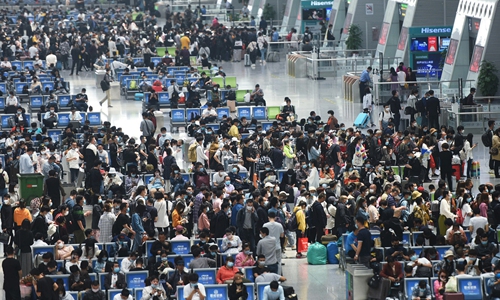
Tourists wait for their trains at Hangzhou East Railway Station on Tuesday as the 5-day May Day holiday ends. Photo: VCG
Long-waited rebound
During the five-day holiday, Chinese travelers made a total 115 million trips, down 41 percent compared to last year, according to data from the Ministry of Culture and Tourism on Tuesday. Total tourism spending reached 47.6 billion yuan ($6.74 billion), down nearly $10 billion from last year, the ministry said.
Although the figures are significantly down from previous years, they are exceeding expectations, analysts noted, pointing out that restrictions are still in place in many areas across the country aimed at preventing a second wave of the epidemic and so some inevitably steered clear of travel.
"It was a big test for both economic recovery and epidemic prevention and it is fair to say that we passed the test," Jiang Yiyi, professor of the leisure sports and tourism school of Beijing Sport University, told the Global Times on Tuesday.
It is worth noting that even as hundreds of millions of people traveled during the holidays, there were no reported new clusters of infections as of noon on Tuesday. During the holiday, China reported seven new confirmed cases, six imported.
This year marks the first time in 12 years that China extended the three-day May Day holiday to five days, a measure designed specifically to boost consumption and economic growth.
May Day holiday tested China's ability to recover amid the risks of a resurgence, analysts noted.
Beyond the data, the enthusiasm of Chinese travelers was palpable on the streets of Beijing over the holidays and in countless online pictures of popular attractions across the country, including Wuhan, Central China's Hubei Province, hit hardest by the epidemic.
In a clear sign of a nationwide recovery, Hubei opened up 22 main tourist sites for the May Day holiday, receiving a total of about 7.36 million trips and 2.45 billion yuan in tourism revenue, official data showed on Tuesday. But the number of trips at most sites was down as much as 80 percent from last year.
In Beijing, officials also lowered the public emergency response level and lifted certain travel restrictions ahead of the holiday to boost travel.
The capital city received 4.63 million trips, about 55 percent of last year's figure, and raised revenue of 4.18 billion yuan, about 36 percent of last year, official data showed.
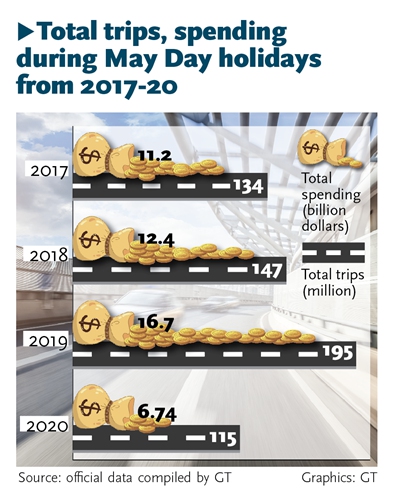
"These are extraordinary figures, considering that there are still a lot of restrictions in place to prevent the spread of the novel coronavirus," Cao Heping, a professor of economics at Peking University in Beijing, told the Global Times on Tuesday.
Although restrictions were relaxed in Hubei and Beijing, strict anti-epidemic measures remained in place across a country on high alert for a resurgence of the epidemic.
Tourism ministry officials noted that 30 percent of tourism sites across the country did not open and many limited visitors to about 30 percent of normal capacity.
"Both demand and supply are still under pressure for the tourism sector," Jiang said.
Restrictions and concerns did not stop many spending money online and offline on clothes, home appliances, food and gold.
Electronics retailer Suning.com said a new store in Nanjing, East China's Jiangsu Province saw sales exceeding 200 million yuan on its opening day. Online, sales of air-conditioning units surged 482 percent, refrigerators jumped 310 percent and washing machines 342 percent, the company said in a statement to the Global Times on Tuesday.
In Shanghai, an online shopping festival with livestreaming, discount and other sales promotions had generated more than 10 billion yuan as of 2 pm Tuesday.
In Guangzhou, South China's Guangdong Province, Chinese moms, affably dubbed "dama," reported emptied shelves of certain types of gold bars.
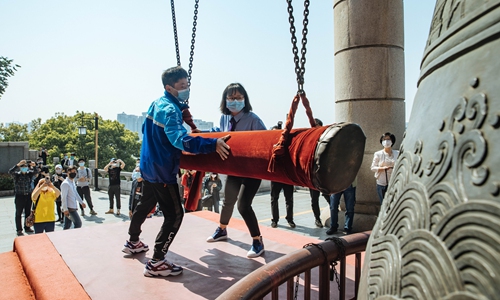
In a symbol of good luck, two people clang the bell at Wendesday's reopening ceremony of Huanghelou, or Yellow Crane Tower, a Wuhan landmark which had been closed for 98 days due to the coronavirus. The tourist spot has put measures in place to control crowds and ensure visitor safety. Photo: Li Hao/GT
'Shot in the arm'
"What this May Day holiday tells us is that the enthusiasm of Chinese consumers has not been curbed by the epidemic too much," Cao said.
Tourism and consumption were among the sectors most affected by the epidemic and such a recovery was a "shot in the arm" for the Chinese economy, he noted.
Chinese officials have been focused on boosting domestic consumption, which contributes about 60 percent to total GDP growth.
Apart from relaxing certain travel restrictions, governments introduced a slew of measures to boost consumption, including coupons.
During the holiday, at least 68 cities across the country launched trillions of yuan in coupons to boost consumption, according to the domestic news portal Jiemian.com.
Cao said that if the pandemic did not resurge and consumption continued to rebound, even at the current pace, China would be able to make up the historic 6.8 percent fall in GDP in the first quarter and achieve GDP growth of between 3.5 and 5.5 percent this year.
Many Chinese analysts noted that the most important takeaway from the May Day holiday was not just the rebound in tourism and consumption, but a valuable lesson in how the country could strike a balance between economic reopening and epidemic prevention.
"This gave us very good information that if we take effective measures to prevent the spread of the virus, we can gradually reopen the economy," Cai Jiangnan, director of the center for healthcare management at the China Europe International Business School, told the Global Times.
"If we do it right, we can take care of both."

